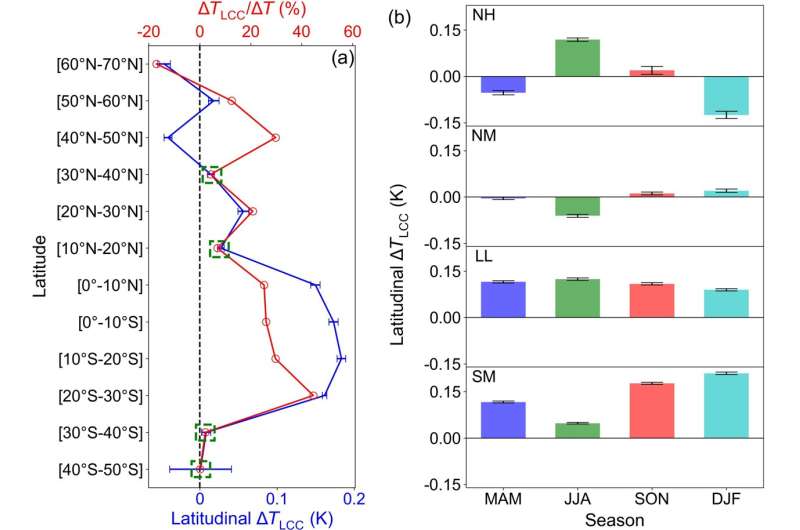This article has been reviewed according to Science X's editorial process and policies. Editors have highlighted the following attributes while ensuring the content's credibility:
fact-checked
trusted source
proofread
Satellite observations reveal latitudinal variability and asymmetry in local temperature responses to land cover changes

Land cover changes (LCCs) affect surface temperatures at local scale through biophysical processes. However, limited by the coarse spatial resolution of available data, past observation-based studies mainly focused on the potential effects of virtual afforestation/deforestation using the space-for-time assumption. Prof. Li and his team first generated a high-resolution temperature dataset and then explored the actual effects of all types of realistic LCCs by adopting the space-and-time scheme and utilizing extensive satellite observations.
They identified a total of 529,128 1-km pixels experienced LCC from 2006 to 2015. The widely studied afforestation/deforestations accounted for 46.28%, whereas previously underexplored transitions within non-forest vegetation types and almost unnoticed changes involving non-vegetation types occurred with proportions of 18.62% and 35.10%, respectively, illustrating the necessity to explore the comprehensive influences of all LCC types instead of considering only the influences of forest changes, as has been done in previous research.
The average temperature in the areas with LCCs increased by 0.08 K globally but varied significantly across latitudes, ranging from -0.05 K to 0.18 K. These effects accounted for up to 44.6% of overall concurrent warming, emphasizing the importance of LCC biophysical influences. By comparing the importance of different LCC processes within a unified framework, the researchers found that cropland expansions dominated cooling effects in the northern mid-latitudes, whereas forest-related LCCs caused warming effects elsewhere.

Unlike the symmetric assumption of potential effects, the researchers revealed obvious asymmetries in the actual effects: LCCs with warming effects occurred more frequently, with stronger intensities, than LCCs with cooling effects. Even for the mutual changes between two covers in the same region, warming LCCs generally had larger magnitudes than their cooling counterparts. Attribution analysis indicated that the asymmetric temperature effects were caused by a combination of asymmetric changes in transition fractions and driving variables.
These findings demonstrated that the increase in temperature resulting from a specific LCC cannot be counteracted by simply performing its reverse LCC of the same area during the same period, providing a new perspective on land management and climate adaptation policies.
The study is published in the journal Science Bulletin.
More information: Xiangyang Liu et al, Local temperature responses to actual land cover changes present significant latitudinal variability and asymmetry, Science Bulletin (2023). DOI: 10.1016/j.scib.2023.09.046
Provided by Science China Press




















